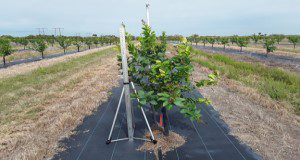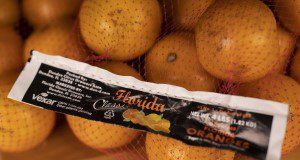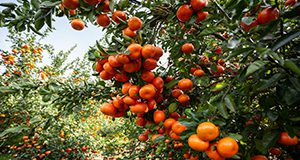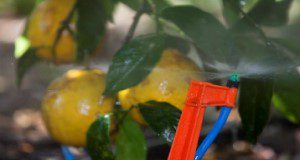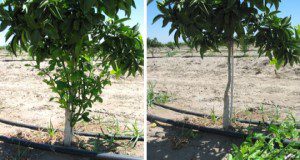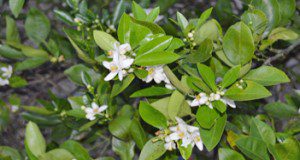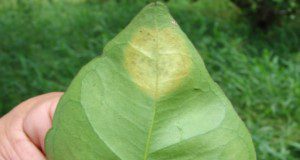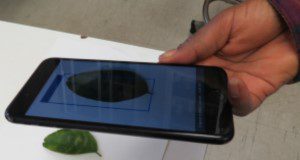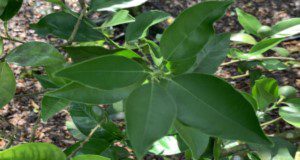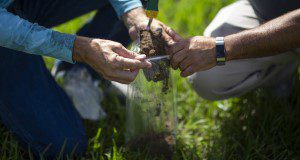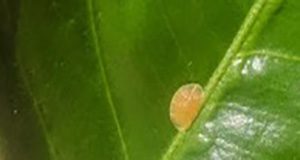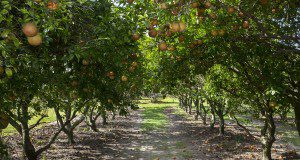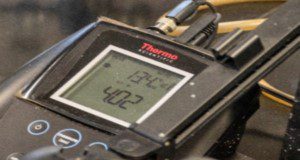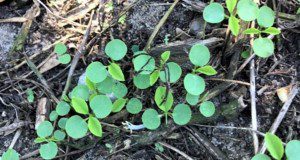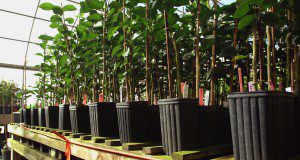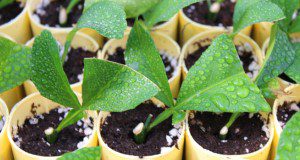Young citrus trees require optimal irrigation management for vigorous vegetative growth, leaf flushing, and establishment of a dense canopy. Poor irrigation practices, such as infrequent irrigation or irrigating without using irrigation scheduling tools, could be costly. Besides excessive loss of water and nutrients, the growth of young trees might be impacted by an excess or deficit of water. Crop water stress in young trees directly affects yield and fruit quality. This new 2-page publication of the UF/IFAS Department of Soil and Water Sciences, written by Davie Kadyampakeni and Sandra Guzmán, covers some strategies for optimizing young tree care and irrigation management to in turn optimize grove efficiency and productivity.
https://edis.ifas.ufl.edu/ss701
Category: Citrus
Quick Reference Guide to Postemergence Herbicides for Citrus Weed Control
This quick reference table will provide growers with information (suggested rates, use restrictions, etc.) on different herbicides used in citrus. The herbicide table, prepared based on the Florida Citrus Production Guide, will aid growers to select an appropriate postemergent herbicide program in citrus groves. Written by Ramdas Kanissery, Camille E. McAvoy, Jamie D. Burrow, Stephen H. Futch, Brent A. Sellers, and S. Shea Teems, and published by the UF/IFAS Horticultural Sciences Department.
https://edis.ifas.ufl.edu/hs1410
Common Questions When Using Soil Moisture Sensors for Citrus and Other Fruit Trees
This guide is for Extension personnel who may encounter questions from growers about the functioning and accuracy of soil moisture sensors (SMSs) for fruit tree production. The 4-page publication focuses on two types of handheld sensors currently used in Florida for irrigation management of citrus and other trees: the transmission line oscillator (TLO) and time-domain transmissometer (TDT). Written by Eric Herrera, Sandra M. Guzmán, and Eduart Murcia, and published by the UF/IFAS Department of Agricultural and Biological Engineering, February 2021.
https://edis.ifas.ufl.edu/ae551
Nutrition and Irrigation Management for Florida HLB-Affected Trees
To improve production of huanglongbing (HLB) affected trees, nutrition, irrigation, and soil pH should be considered together, because each can influence the efficacy of the others in overcoming the effects of HLB on tree performance. This two-sided poster published by the UF/IFAS Horticultural Sciences Department through the UF/IFAS Citrus Research and Education Center was written by Tripti Vashisth, Davie Kadyampakeni, and Jamie D. Burrow.
https://edis.ifas.ufl.edu/hs1367
Management of Citrus Tree Canopies for Fresh-Fruit Production
Canopy management is a useful tool to induce precocity and maintain high production of optimum-sized, high-quality fruit. The aim of this new 8-page publication of the UF/IFAS Department of Soil and Water Sciences is to provide growers with practical tools with which to manage their trees for maximum fresh-fruit yield, quality, and profitability. Written by Andrew Krajewski, Arnold Schumann, Tim Ebert, Chris Oswalt, Rhuanito S. Ferrarezi, and Laura Waldo.
https://edis.ifas.ufl.edu/ss698
Management Options for Improving Flowering in Citrus Production
The final fruit yield and, ultimately, returns a grower receives from any given harvest is directly related to the number of viable flowers that are generated and the proportion of those flowers that produce fruit. A grower can improve the ability for their trees to consistently produce a profitable crop of fruit by understanding the steps involved in flowering and controlling the transition to reproductive growth. This new 6-page publication of the UF/IFAS Horticultural Sciences Department was written by Leigh Archer, Miurel Brewer, Bikash Adhikari, Eduardo Esteves, Christopher Vincent, and Tripti Vashisth.
https://edis.ifas.ufl.edu/hs1399
Citrus Diseases Exotic to Florida: Citrus Leprosis
This article is one in a series designed to provide important information on the causal agent, symptoms, and transmission of exotic citrus diseases. Disseminating the information about the diseases to the citrus industry may prevent their introduction and spread in Florida. This 5-page document will focus on the exotic viral disease citrus leprosis. This is a major revision of an article originally published in 2006. Written by O. Batuman, A. Levy, P. Sieburth, A. M. Paolillo, K.-R. Chung, and R. H. Brlansky, and published by the UF/IFAS Plant Pathology Department.
https://edis.ifas.ufl.edu/pp148
Computer Tools for Diagnosing Citrus Leaf Symptoms (Part 2): Smartphone Apps for Expert Diagnosis of Citrus Leaf Symptoms
Visual identification of nutrient deficiencies in foliage is an important diagnostic tool for fine-tuning nutrient management of citrus. This new 2-page article describes a new smartphone app that uses a trained neural network to identify disease and pest symptoms on citrus leaves through your phone’s camera. Written by Arnold Schumann, Laura Waldo, Perseveranca Mungofa, and Chris Oswalt, and published by the UF/IFAS Department of Soil and Water Sciences.
https://edis.ifas.ufl.edu/ss691
Nutrition of Florida Citrus Trees, Third Edition
This update to 2007’s second edition adds information regarding nutrition of Florida citrus trees affected by huanglongbing (HLB), also known as citrus greening. Much of the guidance provided in this document on nutrients, application methods, leaf and soil sampling, and irrigation scheduling is also effective for trees affected by HLB. However, research conducted since the previous edition was published has established changes in many production practices, including nutrient rates, irrigation scheduling, soil pH management, and use of Citrus Under Protective Screen (CUPS). Changes to the second edition will appear at the beginning of chapters 2, 6, 8, 9, and 11. See also this topic page for links to individual chapters in HTML and PDF formats. This 115-page book was edited by Kelly T. Morgan and Davie M. Kadyampakeni, and published by the UF/IFAS Department of Soil and Water Sciences.
https://edis.ifas.ufl.edu/ss478
Citrus Leaf Sampling Procedures for Nutrient Analysis
To maintain balanced nutrients for optimal tree growth, citrus growers need to assess trees’ nutritional requirements. These assessments help prevent any nutrient deficiency or toxicity from compromising tree health and yield or reducing revenue. This new illustrated two-page instructional sheet gives a basic procedure for the citrus leaf sampling process, as well as additional suggestions for HLB-affected trees. Written by Tripti Vashisth, Jamie D. Burrow, Davie Kadyampakeni, and Rhuanito S. Ferrarezi, and published by the UF/IFAS Horticultural Sciences Department.
https://edis.ifas.ufl.edu/hs1355
Soil Sampling Procedures
To achieve optimal grove nutrition, citrus growers must test grove soil before beginning any fertilization program. Standard procedures for sampling, preparing, and analyzing soil should be followed for meaningful interpretations of the test results and accurate recommendations. This new two-page fact sheet, published by the UF/IFAS Department of Soil and Water Sciences, provides illustrated soil sampling procedures and tables to aid in basic interpretation of lab results. Written by Davie Kadyampakeni, Kelly Morgan, Arnold Schumann, and Rhuanito S. Ferrarezi.
https://edis.ifas.ufl.edu/ss667
Citrus Pest Quick Guide: Brown Soft Scale (Coccus hesperidum Linnaeus)
A one-page quick guide written by Lauren M. Diepenbrock and Jamie D. Burrow and published by the Entomology and Nematology Department presents the life cycle of brown soft scale and provides several photos of the pest and the damage it causes to assist in identification.
https://edis.ifas.ufl.edu/in1252
Florida Citrus Rootstock Selection Guide, 4th Edition
This updated 4th edition of the Florida Citrus Rootstock Selection Guide (FLCRSG) is a revision of the 2016 publication. The guide is a convenient, easy-to-use reference to 21 characteristics of 49 rootstocks. Of those, 12 are time-honored commercial rootstocks (highlighted in blue), which are the most reliably characterized. The next 13 rootstocks are minor commercial ones (highlighted in green) that are less frequently used today in Florida but may have been prominent at one time. The third group consists of the most recently released 24 rootstocks (highlighted in yellow) for which there is limited commercial experience. The new addition includes three new USDA rootstocks and updates information on a few traits. Written by William S. Castle, Kim D. Bowman, Jude W. Grosser, Rhuanito Soranz Ferrarezi, Stephen H. Futch, and Steve Rogers, and published by the UF/IFAS Horticultural Sciences Department.
https://edis.ifas.ufl.edu/hs1260
Citrus Soil pH Testing Procedures
Maintaining the correct soil pH is essential to ensure optimal plant growth and crop yield. This new two-page document is an instructional sheet for citrus soil pH testing, written by Kelly Morgan and published by the UF/IFAS Department of Soil and Water Sciences.
https://edis.ifas.ufl.edu/ss665
Citrus Soil pH Management
Management of both soil pH and nutrients is required to maintain soil fertility levels and ensure economic agricultural production. Maintaining soil in the 6.0-6.5 pH range is best for most crops including citrus. This new two-page publication of the UF/IFAS Department of Soil and Water Sciences, written by Kelly Morgan, explains the effects of soil pH on citrus as well as options for management.
https://edis.ifas.ufl.edu/ss666
Stock Plant and Tree Production: Weed Management in Citrus Nurseries
All citrus nursery stock in Florida is raised in enclosed greenhouses. It is not uncommon for weeds to grow in containers, where they compete with citrus seedlings, and on greenhouse floors, where they can harbor pests and diseases. This new 7-page publication of the UF/IFAS Horticultural Sciences Department provides descriptions of a few commonly found weeds in citrus nurseries and good weed management practices. Written by Biwek Gairhe, Ramdas Kanissery, and Brent Sellers, this article is chapter 8c of the forthcoming Citrus Nursery Production Guide.
https://edis.ifas.ufl.edu/hs1344
Identification and Management of Clustered Pellitory (Parietaria praetermissa) in Citrus Groves
In Florida, clustered pellitory is becoming a troublesome weed for citrus, especially from the winter through early summer. Inadequate management of this weed can result in its heavy infestation in tree rows and can interrupt the spray pattern of low-volume drip irrigation systems. This new 3-page publication of the UF/IFAS Horticultural Sciences Department will assist Florida citrus growers with proper identification of clustered pellitory and with adoption of adequate and timely strategies to manage this weed in their groves. Written by Ramdas Kanissery, Biwek Gairhe, Brent Sellers, and Steve Futch.
https://edis.ifas.ufl.edu/hs1341
Rootstock Selection
The large number of different rootstock varieties currently available for citrus production in Florida is unprecedented. This new 4-page article, chapter 4 of the forthcoming UF/IFAS Citrus Nursery Production Guide, provides information on rootstock uses in Florida, rootstock propagation, and the impact of tissue culture, as well as factors to consider when deciding which rootstock to plant. Written by Ute Albrecht, Manjul Dutt, and Jude Grosser and published by the UF/IFAS Horticultural Sciences Department.
https://edis.ifas.ufl.edu/hs1340
Seed and Budwood Production, Transport, and Conservation
The Florida citrus industry maintains a high demand for trees for replanting and resetting, as well as an interest in new releases of rootstocks and scions with improved disease and abiotic stress tolerances. One of the main constraints for liner production in great numbers is time. The consensus among citrus nurseries is that it takes two years to produce enough quantities of budwood to establish seed block trees when a new interesting rootstock is produced. This new 3-page article addresses the practices and challenges of producing seeds and budwood in Florida. This article, chapter 7 of the forthcoming Citrus Nursery Production Guide, was written by Fernando Alferez and Mireia Bordas and is a publication of the UF/IFAS Horticultural Sciences Department.
https://edis.ifas.ufl.edu/hs1336
Citrus Rootstock Propagation: Traditional Techniques and Recent Advances
Commercially grown citrus trees are usually composed of two parts: 1) the scion, which is the aboveground portion of the tree that produces the fruit, and 2) the rootstock, which comprises the root system and the lower portion of the trunk. This new 4-page publication, chapter 6 of the forthcoming Citrus Nursery Production Guide, discusses three kinds of rootstock propagation: seed, cuttings, and tissue culture. Written by Ute Albrecht, Lorenzo Rossi, and Mongi Zekri and published by the UF/IFAS Horticultural Sciences Department.
https://edis.ifas.ufl.edu/hs1329
